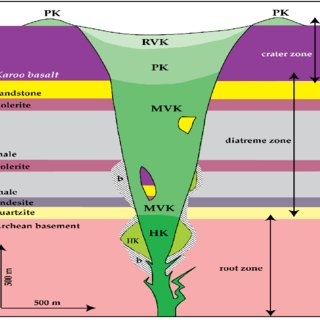 |
| Diagram of a kimberlite pipe |
Despite her B.S. degree (in business and human resources?), it's apparent that Lindstrom was woefully unprepared to answer this question. Nevertheless, she forged ahead... opening by "explaining" that,
"All of Earth's minerals found in present-day mining formed from the primordial soup that was once our slowly cooling planet."
In the first place, "primordial soup" is far more likely to refer to the origins of life than to the origins of minerals. More on point, however, is the fact that, despite Deb's poetic explanation, earth's mineral riches are of all ages. In fact, some ores are being emplaced as we speak to be mined millions of years down the road by the descendants of modern cockroaches (or whatever).
Moving right along, Lindstrom managed to conflate mineral ores in general with the highly unusual emplacement of diamonds in kimberlite pipes, erroneously telling her readers that,
"As the minerals formed into distinct types, they were pushed up through openings in the Earth's newly forming crust, leaving a "pipe" (trail) that, even if faint to the untrained eye, points to the highest concentrations of a given mineral..."
...which, sad to say, is utter bullshit. Even the kimberlite pipes associated with diamonds – the only "pipe-related" gems – are well-defined and easily recognized by a prospector. There are not, however, bauxite pipes (aluminum ore), hematite pipes (iron ore), or even pitchblende pipes (uranium ore). Lindstrom went on to make a hash of the science involved, telling her readers that,
- "Diamonds of value do not form within Earth's magma..." – We think she meant within the crust.
- "This rock is in the upper mantle of the Earth's crust..." – Sorry, Deb, but the upper mantle is not part of the crust. Perhaps you were confused by the definition of lithosphere, which comprises the crust and upper mantle. Perhaps.
- "[kimberlite?] crystallizes with the help of minerals known as peridotites and eclogites..." – Peridotite and eclogite are rock types, not minerals, and they don't "help" anything form. They happen to be present in the same PT regime...
- ""Pipes of the minerals kimberlite and lamproite are often present in the Earth's upper mantle... – Fist, kimberlite and lamproite are rock types, not minerals. Second, they're quite rare... otherwise there would be hella more diamonds around!
- "These minerals are resistant to weathering and are denser than quartz sand. As such, kimberlite and lamproite float to and gather in streambeds. " – First, ultrabasic rocks like kimberlite and lamproite are FAR LESS resistant to weathering than quartz and second, the stuff doesn't "float" anywhere.
|
Lindstrom had a lot more to say, mostly about Crater of Diamonds State Park (Arkansas) and diamond mining around the world. What she never actually got around to doing, however, was to answer the question... mostly because she couldn't. The best answer anyone could come up with is "weathered kimberlite." The rock itself is typically dark, but the presence of large amounts of iron results in concentrations of the yellowish-brown iron oxide mineral limonite in the soil.
Lindstrom could probably have found that information, but we're pretty certain our Dumbass of the Day wouldn't have known what to do with it. Feh.
|
SI - PETROLOGY
No comments:
Post a Comment